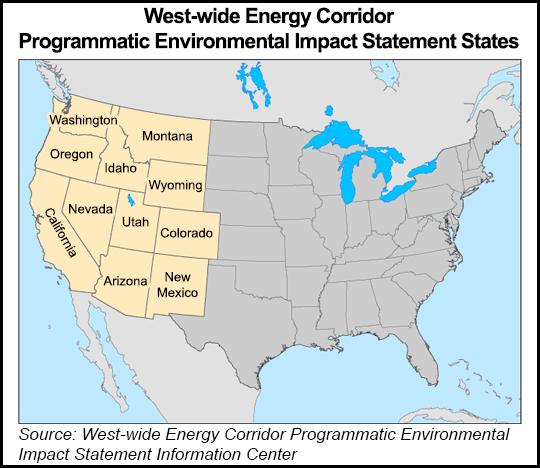NGI The Weekly Gas Market Report
NGI The Weekly Gas Market Report | Daily GPI | Infrastructure | NGI All News Access
Input Sought on Western Energy Transport Corridors
Federal agencies on Friday issued a request to the public to assist in an ongoing review to implement energy transport corridors in 11 western states, across more than 6,000 acres of federal land, for future natural gas, oil and hydrogen pipelines, and electricity transmission/distribution facilities.

The big focus for the energy corridors is for 100 kV and larger transmission projects, as well as gas, oil and hydrogen pipelines 10 inches or more in diameter.
The interagency working group for the energy corridors consists of the Bureau of Land Management (BLM), the U.S. Forest Service (USFS) and DOE. Under Section 368 of the Energy Policy Act of 2005, the departments of Agriculture, Commerce, Defense, Energy and Interior were authorized to designate the corridors. Section 368 corridors were designated for Arizona, California, Colorado, Idaho, Montana, Nevada, New Mexico, Oregon, Utah, Washington and Wyoming.
The Bush administration unveiled the plan in late 2008, and the corridors were designated in 2009 (see Daily GPI, Dec. 1, 2008). The final programmatic environmental impact statement (PEIS) designated the energy transport corridors. Shortly after the PEIS was issued, several nonprofits filed a lawsuit claiming the corridors were “coal friendly” and in direct opposition to nine of the states’ renewable portfolio standards (see Daily GPI, July 9, 2009).
The federal agencies and the plaintiffs settled the lawsuit last year (Wilderness Society v. United States Department of the Interior, No. 3:09-cv-03048-JW). The request for information(RFI) published in the Federal Register on Friday builds on the settlement agreement to solicit more public comments on the study and provide a foundation for an initial regional periodic review.
“The RFI is an important step for the BLM, USFS and DOE’s efforts to determine if Section 368 Corridors should be modified to better serve public interests,” BLM noted.
The information sought by the RFI covers the corridor study and the regional periodic review of the corridors. Because the original corridors were designed with data available prior to 2009, the agencies are interested in obtaining updated geographic information system information that may affect the corridors’ locations. The agencies also want to know if the public thinks there should be other types of projects considered in the corridors.
Comments have to be submitted by May 27 and may be sent electronically to 368corridors@blm.gov. More information is available by contacting BLM’s Stephen Fusilier at (202) 912-7426 or sfusilie@blm.gov.
© 2024 Natural Gas Intelligence. All rights reserved.
ISSN © 1532-1231 | ISSN © 2577-9877 | ISSN © 1532-1266 |
